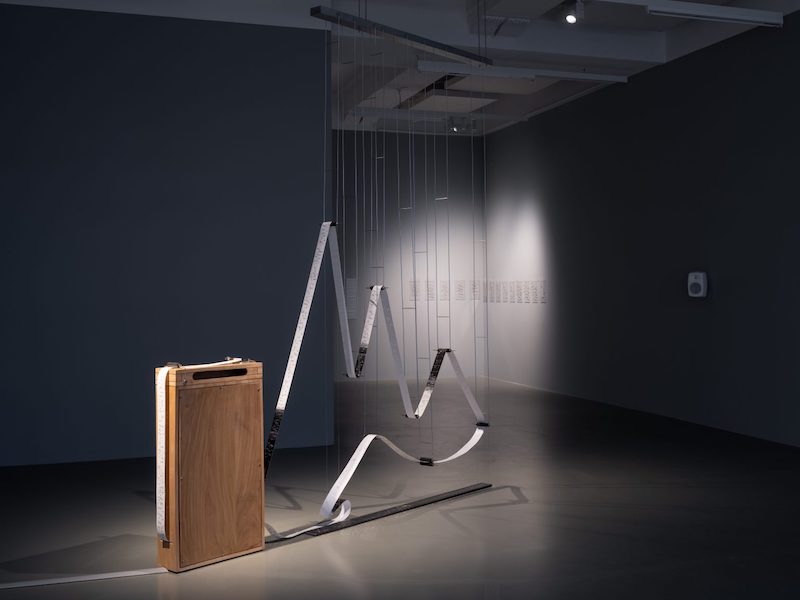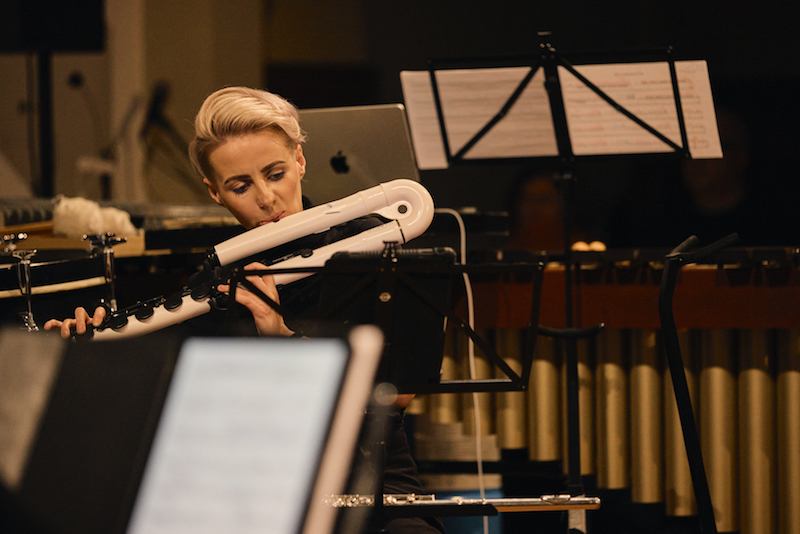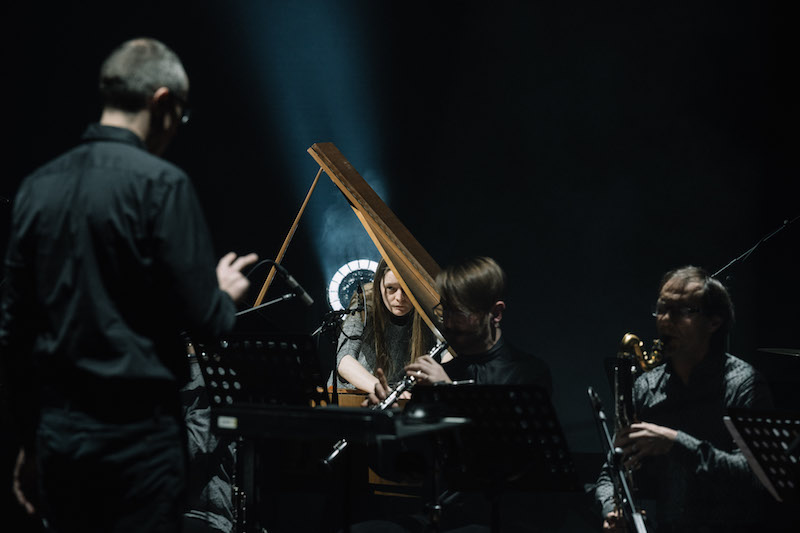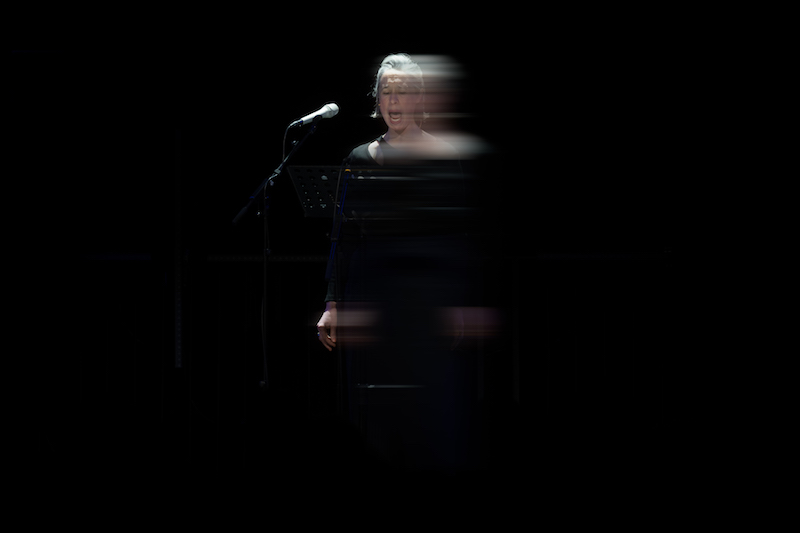by Dagmara Genda // Mar. 30, 2023
This year, MaerzMusik is no longer the “Festival for Time Issues.” In fact, there is no subtitle giving context to the annual spring event; its name, now printed in a bold fat font atop a burgundy background, is understood as context enough. The start of a new chapter can also be felt in the programming, which has been taken over by curator, music journalist and electronic musician, Kamila Metwaly and, at least for this edition, co-curated by composer and conductor Enno Poppe. Though Metwaly’s interest lies in the interweaving of performance and exhibition practices to engage sound cultures and histories beyond the Euro-American canon, this festival didn’t move away from the presentation of music as many of us know it; it embraced it with one of the fullest concert programmes in years. This is likely due to Poppe’s influence, who is the conductor of ensemble mosaik and has written music for ensemble musikfabrik, both of which performed in this year’s festival. The result of this collaboration was a festival that was less concerned with reconfiguring terms and more invested in opening new auditory experiences.

Nandita Kumar: ‘From Paradigm to Paradigm, Into the Biomic Time,’ 2023, sound installation at daadgalerie // Photo by Thomas Bruns
All this is not to claim that the exhibition and discursive component of the festival has disappeared. It does seem, however, with the introduction of the MaerzMusik Library, more clearly delineated this year. Savvy Contemporary, where Metwaly has been organising sound-based exhibitions since 2017, was once again a partner with the presentation of ‘Lakbayan: Voices of Resistance from the Philippines,’ curated by Dang A Dang Radio. The on-going archive exhibition features listening stations, texts and album covers of protest music in the Philippines. The final week of 2022 Music & Sound Fellow Nandita Kumar’s exhibition at daadgalerie was also rolled into the MaerzMusik programme. As spatial presentations, the shows could address music from different perspectives—the historical-political at Savvy and the conceptual at daadgalerie—and situate sonic practices within a broader social and aesthetic context.
This is decidedly trickier in a concert, where audience attention and sensory response take precedence over intellectual contemplation. The two pieces that made explicit attempts to engage a broader theme, Laura Bowler’s ‘FFF’ (2017) and Laure M. Hiendl’s ‘Songs for Captured Voices’ (2023), collapsed into sloganeering, risking a disservice to the complex themes they engaged. In ‘FFF,’ Bowler herself stands before the audience wearing white leggings patterned with angry emoji faces, while operatically railing against slacktivism and contemporary social media politics. In Hiendl’s ‘Songs for Captured Voices,’ Elaine Mitchner’s renowned vocal flexibility is tamed by the defiant and indignant repetition of what came off as hashtag pronouncements, accentuated by the fact that she read them off a tablet. The background inspiration for the project—namely audio recordings from German prisoner-of-war camps—disappeared behind righteous but ultimately contextless proclamations.

Musikgenossenschaft / Spółdzielnia Muzyczna, March 20, 2023 at Villa Elisabeth / St. Elisabeth Church // © Fabian Schellhorn / Berliner Festspiele
The highlights, however, were many. They included the works of young composers, such as Paweł Malinowski’s ‘title unknown’ (2022): a fragile, tentative piece for six instruments and electronics, a homage to forgotten artists. The work was written for and played by Spółdzielnia Muzyczna, a Krakow-based contemporary ensemble, who write that art “makes us face difficult questions, precisely by confronting them.” This they do through the vehicle of abstract sound. They also played Artur Zagajewski’s ‘Mechanofaktura’ (2015), for bass clarinet, violin, percussion, piano and synthesizer, which was an aggressively maximalist take on minimalism, in that each instrumentalist took turns playing a very similar and limited repetition of notes for a set period of time. The result was astonishingly accessible, something between Steve Reich and Colin Stetson, but with the texture of grinding machinery. The work grated, screeched and banged forward, creating tension with subtle differences in timing and intonation.

Gísladóttir / Thurley / Morgan-Williams / Paxton: ‘Riot Ensemble’ at radialsystem // © Camille Blake / Berliner Festspiele
Equally loud and bombastic was ensemble mosaik’s performance of Sara Glojnaric’s ‘sugarcoating’ #1 (2017) and #3 (2022), pieces based on data provided by the Million Songs Dataset, “a freely available collection of audio features and metadata for a million contemporary popular music tracks.” ‘sugarcoating #1’ had an almost visual, hyperactively cartoonish quality to it, which made it feel like John Adams’ ‘Chamber Symphony’ (1992) on steroids. A combination of meditative and chaotic was Bára Gísladóttir’s ‘Animals of your Pasture’ (2021) played by London’s Riot Ensemble. It climaxed in the droning roar of an electric guitar, while the flute and clarinet seemed to flutter above and even puncture its thickly textured vibration. Electric guitars featured in multiple pieces this year and their presence seemed surprising, even quaint, an instrument both out of date and comically futuristic.

Rebecca Saunders: ’The Mouth’ (2018-2020) for soprano and tape, Variations on a Voice, Saunders / Miller / Dunn / Fraser / Baskind at Radialsystem // © Camille Blake / Berliner Festspiele
A returning feature was Rebecca Saunders, who last year presented the growling ‘Flesh’ (2018) for voice and accordion. This year, she focused on another part of the body. ‘The Mouth’ (2018-2020), for solo soprano and tape, was astonishingly visceral both in sound and visuals. Soprano Juliet Fraser bared and chomped her teeth, her mouth emulating the mechanics of a ventriloquist dummy. With each breath, the mouth became objectified, nothing more than an opening into the cavern of the body, through which moving air causes whispers, whistles, hisses and screeches like from a boiling tea kettle. Saunders somehow blurs subject and object to succeed in making the body an instrument, a thing with tubes and openings that, when squeezed the right way, can produce an astonishing variety of sound.
There was a palpable freedom to the festival this year that expressed itself in the diversity and sensuality of its programme, and was perhaps even emphasized by the lack of subtitle, inventively named subsections or overarching brand. Less didacticism represents a trust in the audience as well as a trust in sound—that sensory exploration can hone and foster a perceptual acuity that makes us more sensitive to the world around us.























